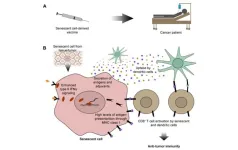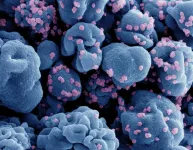(Press-News.org) Organic material from Mars reveals the likely origin of life’s building blocks
Two samples from Mars together deliver the "smoking gun" in a new study showing the origin of Martian organic material. The study presents solid evidence for a prediction made over a decade ago by University of Copenhagen researchers that could be key to understanding how organic molecules, the foundation of life, were first formed here on Earth.
In a meteor crater on the red planet, a solitary robot is moving about. Right now it is probably collecting soil samples with a drill and a robotic arm, as it has quite a habit of doing. NASA's Curiosity rover has been active on Mars as the extended arm of science for nearly 12 years, and it continues to make discoveries that surprise and challenge scientists' understanding of both Mars and our own world here on Earth.
Most recently, the discovery of sedimentary organic material with particular properties has had many researchers scratching their heads. The properties of these carbon-based materials, in particular the ratio of its carbon isotopes, surprised researchers.
Organic materials with such properties, if found on Earth, would typically be a sign of microorganisms, but they can also be the result of non-biological, chemical processes. The find obviously had researchers scrambling for a clear answer, but nothing seemed to fit.
However, for the research collaboration behind a new study published in Nature Geoscience, there has been little hair scratching and much enthusiasm.
In fact, the discovery on Mars provided the missing piece that made everything fall into place for this group of researchers from the University of Copenhagen and the Tokyo Institute of Technology.
As co-author and chemistry professor Matthew Johnson puts it, it is "the smoking gun" needed to confirm a decade old theory of his about so-called photolysis in Mars' atmosphere.
With the Curiosity sample, the new research is able to prove with reasonable certainty that the Sun broke down CO2 in the Martian atmosphere billions of years ago - as the old theory predicted. And that the resulting carbon monoxide gradually reacted with other chemicals in the atmosphere synthesizing complex molecules – and thus providing Mars with organic materials.
“Such carbon-based complex molecules are the prerequisite of life, the building blocks of life one might say. So, this it is a bit like the old debate about which came first, the chicken or the egg. We show that the organic material found on Mars has been formed through atmospheric photochemical reactions - without life that is. This is the 'egg', a prerequisite of life. It still remains to be shown whether or not this organic material resulted in life on the Red Planet." said Johnson and continued:
“Additionally because Earth, Mars and Venus had very similar CO2 rich atmospheres long ago when this photolysis took place, it can also prove important for our understanding of how life began on Earth,” said Professor Matthew Johnson from Department of Chemistry at University of Copenhagen.
Two pieces separated by 50 Million Kilometers – one puzzle solved
12 years ago Johnson and two colleagues used simulations based on quantum mechanics to determine what happens when a CO2 rich atmosphere is exposed to the UV-light of the Sun, in a process known as photolysis.
Basically, on Mars around 20% of the CO2 is split into oxygen and carbon monoxide. But carbon has two stable isotopes: carbon-12 and carbon-13. Usually they are present in a ratio of one carbon-13 for every 99 carbon-12. However, photolysis works faster for the lighter carbon-12, so the carbon monoxide produced by photolysis has less carbon-13 (is depleted), and the left over CO2 has more (is enriched).
Because of this, Johnson and his colleagues were able to make very precise predictions of the ratio of carbon isotopes after photolysis. And this gave them two distinctive fingerprints to look for. One of these was identified in a different Martian sample, years ago.
“We actually have a piece of Mars here on Earth, which was knocked off that planet by a meteorite, and then became one itself, when it landed here on Earth. This meteorite, called Allan Hills 84001 for the place in Antarctica where it was found, contains carbonate minerals that form from CO2 in the atmosphere. The smoking gun here is that the ratio of carbon isotopes in it exactly matches our predictions in the quantum chemical simulations, but there was a missing piece in the puzzle. We were missing the other product of this chemical process to confirm the theory, and that's what we've now obtained," says Matthew Johnson.
The carbon in the Allan Hills meteorite is enriched in carbon-13, which makes it the mirror image of the depletion in carbon-13 that has now been measured in the organic material found by Curiousity on Mars.
The new study has thus linked data from two samples, which researchers believe have the same origin in Mars' childhood but were found more than 50 million kilometers apart.
“There is no other way to explain both the carbon-13 depletion in the organic material and the enrichment in the Martian meteorite, both relative to the composition of volcanic CO2 emitted on Mars, which has a constant composition, similar as for Earth’s volcanos, and serves as a baseline,” said Johnson
Hope to find the same evidence on Earth
Because the organic material contains this isotopic “fingerprint” of where it came from, researchers are able to trace the source of the carbon in the organic material to the carbon monoxide formed by photolysis in the atmosphere. But this also reveals a lot about what happened to it in between.
“This shows that carbon monoxide is the starting point for the synthesis of organic molecules in these kinds of atmospheres. So we have an important conclusion about the origin of life’s building blocks. Although so far only on Mars,” said Matthew Johnson.
Researchers hope to find the same isotopic evidence on Earth, but this has yet to happen, and it could be a much bigger challenge because our geological development has changed the surface significantly compared to Mars, Johnson explains.
"It is reasonable to assume that the photolysis of CO2 was also a prerequisite for the emergence of life here on Earth, in all its complexity. But we have not yet found this “smoking gun” material here on Earth to prove that the process took place. Perhaps because Earth's surface is much more alive, geologically and literally, and therefore constantly changing. But it is a big step that we have now found it on Mars, from a time when the two planets were very similar," says Matthew Johnson.
*
Facts: Organic material
The sample found on Mars contains deposits of so-called organic material. To laymen this may sound more exciting than it is. Organic material in a chemical context does not necessarily mean something living, as one might normally think. The term covers molecules that contain carbon and at least one other element and can easily exist without life. These molecules are rather the building blocks of life.
Facts: What is Photolysis
Photolysis means that the Sun's UV rays provide molecules with energy to perform a chemical transformation. According to the research this happened in the Martian atmosphere, where 20% of CO2 molecules there were split into oxygen and carbon monoxide.
In earlier research, Johnson and colleagues showed that carbon dioxide containing the carbon-12 isotope is photolysed more quickly than the heavier isotope carbon-13.
Over time, CO is produced that is depleted in 13C, and 13C builds up in the remaining CO2. This results in so-called isotopic enrichment in CO2 and depletion in CO, like mirror images or each other or the two halves of a broken plate.
It is the fractionation ratio in carbon, which serves as evidence of photolysis in the two samples from Mars.
Facts: The oxygen painted Mars red
Photolysis of a CO2 molecule yields carbon monoxide (CO) and an oxygen atom (O). On Mars, only carbon monoxide remains, which is transformed into the organic material found by the Curiosity rover.
But where the oxygen has gone is also no secret. The oxygen combines into O2, which interacts with iron on Mars' surface. The Red Planet is rust red due to oxidized iron.
Facts: Isotopes Have Different Weights
Isotopes are variants of the same element that have different weights because the nucleus contains more or fewer neutrons.
Carbon has two stable isotopes - Normally, about 99% of carbon has 6 protons and 6 neutrons in its nucleus (12C). About 1% has 6 protons and 7 neutrons instead (13C). The ratio can serve as a chemical fingerprint revealing what reactions the carbon has undergone.
Photolysis favors carbon-12, and a high concentration of the isotope can therefore indicate this process.
Extra Info: The Famous Mars Meteorite
The discovery of organic sediments on Mars with a low ratio of carbon-13 completes the puzzle of empirical evidence for the photolysis theory, since researchers already found the other part of that puzzle years ago in the famous meteorite, Allan Hills 84001. The meteorite contains carbonate with a heightened concentration of heavy carbon 13 isotopes.
Discovered in Antarctica 40 years ago by Roberta Score, the meteorite is believed to originate from the Red Planet and became particularly well known because it contains some deposits that led NASA researchers to announce in 1996 that they believed they had found traces of microscopic fossils of bacteria from Mars.
Today, the consensus is that these deposits are abiotic - that is, stemming from non-biological processes.
Extra info: Mars, Earth, and Venus Had the Same Atmosphere
According to researchers, Earth had approximately the same atmosphere as our neighboring planets Mars and Venus billions of years ago.
When the early planets Venus, Earth, and Mars eventually formed solid surfaces, researchers believe they began to release large amounts of CO2 from extreme volcanic activity. That's how they formed their first atmospheres with large concentrations of the gas. Oxygen had not yet become part of the atmosphere; this happened later on Earth, after the emergence of life.
The photolysis theory states that UV rays from the sun then start a chain of chemical reactions. A chain that starts with the breakdown of CO2 into carbon monoxide, which is the building block for a multitude of other chemical compounds.
Thus, with the help of the Sun, the foundation for the many carbon compounds and complex molecules we have today was formed - in the case of Earth, the foundation for life.
"Since then the fate of the three planets has been significantly different. Earth's carbon dioxide reacted with our large amount of surface water and much of it deposited over time as carbonate rocks like limestone, leaving the atmosphere dominated by nitrogen, as we have today. Life arose, and microorganisms produced oxygen, which, among other things, created our ozone layer, while Mars and Venus still have very CO2-dominant atmospheres today," explains Matthew Johnson.
Today, Venus has a very dense and toxic atmosphere primarily of CO2, which gives it a surface temperature of around 450 degrees Celsius.
On Mars, the atmosphere has become much thinner compared to Earth's, and has left a desert landscape.
About the new study:
The study is published in Nature Geoscience and has just appeared in the journal's June issue.
The following researchers have contributed to the new study:
From the Department of Chemistry at the University of Copenhagen:
Matthew S. Johnson and Johan A. Schmidt
From the Tokyo Institute of Technology:
Yuichiro Ueno, Xiaofeng Zang, Alexis Gilbert, Hiroyuki Kurokawa and Tomohiro Usui
From the University of Tokyo and the Royal Belgian Institute of Space Aeronomy:
Shohei Aoki
END
Organic material from Mars reveals the likely origin of life’s building blocks
Two samples from Mars deliver the "smoking gun" in a study showing the origin of Martian organic material. The study presents evidence for a prediction that could be key to understanding how organic molecules were first formed here on Earth
2024-07-01
ELSE PRESS RELEASES FROM THIS DATE:
Light targets cells for death and triggers immune response with laser precision
2024-07-01
CHAMPAIGN, Ill. — A new method of precisely targeting troublesome cells for death using light could unlock new understanding of and treatments for cancer and inflammatory diseases, University of Illinois Urbana-Champaign researchers report.
Inflammatory cell death, knows as necroptosis, is an important regulatory tool in the body’s arsenal against disease. However, in some diseases, the process can go haywire; for example, cancer cells are able to suppress inflammatory signals and thus escape death.
“Usually treatments for cancer use pharmacological ...
Dr. Harish Manyam revolutionizes cardiac care with innovative device
2024-07-01
Harish Manyam, MD, is on a mission to improve the lives of people with heart problems. His recent accomplishment of implanting Tennessee’s first atrial leadless pacemaker is a step toward that, marking a significant advancement in cardiac care and promising safer and more effective treatment for patients.
The leadless pacemaker, in combination with a novel subcutaneous defibrillator, forms a groundbreaking system that addresses potentially dangerous problems associated with traditional pacemakers and defibrillators.
“This is a great leap forward for the field,” said Dr. Manyam, interim chair of the Department of Medicine at the ...
Want to stay mentally sharp longer? Eat a healthy diet now
2024-07-01
Chicago (July 1, 2024) — Eating a high-quality diet in youth and middle age could help keep your brain functioning well in your senior years, according to new preliminary findings from a study that used data collected from over 3,000 people followed for nearly seven decades.
The research adds to a growing body of evidence that a healthy diet could help ward off Alzheimer’s disease and age-related cognitive decline. Whereas most previous research on the topic has focused on eating habits of people in their 60s and 70s, the new study is the first to track diet and ...
Medication choice may affect weight gain when initiating antidepressant treatment
2024-07-01
Embargoed for release until 5:00 p.m. ET on Monday 1 July 2024
Annals of Internal Medicine Tip Sheet
@Annalsofim
Below please find summaries of new articles that will be published in the next issue of Annals of Internal Medicine. The summaries are not intended to substitute for the full articles as a source of information. This information is under strict embargo and by taking it into possession, media representatives are committing to the terms of the embargo not only on their own behalf, but also on behalf of the organization ...
Weight change across common antidepressant medications
2024-07-01
Boston, MA – New evidence comparing weight gain under eight different first-line antidepressants finds that bupropion users are 15-20% less likely to gain a clinically significant amount of weight than users of sertraline, the most common medication.
The findings are published July 2 in Annals of Internal Medicine.
Antidepressants are among the most commonly prescribed medications in the U.S., with 14% of U.S. adults reporting using an antidepressant. Weight gain is a common side effect, which could affect patients’ long-term metabolic health and cause some to stop taking their prescribed treatment, leading ...
Dampening the "seeds" of hurricanes
2024-07-01
Dampening the "seeds" of hurricanes
Increased atmospheric moisture produced weaker hurricane formation
Increased atmospheric moisture may alter critical weather patterns over Africa, making it more difficult for the predecessors of many Atlantic hurricanes to form, according to a new study published this month.
The research team, led by scientists from the U.S. National Science Foundation National Center for Atmospheric Research (NSF NCAR), used an innovative model that allows for higher-resolution simulations of hurricane formation than ever before. This allowed researchers to study the effects of increased regional moisture over Africa, which is the birthplace of ...
Senescent cell-derived vaccines: A new concept towards an immune response against cancer and aging?
2024-07-01
“[...] cancer immunotherapy based on tumor-associated senescent cells and other types of senescent cells may achieve exciting outcomes beyond cancer therapy.”
BUFFALO, NY- July 1, 2024 – A new review paper was published on the cover of Aging (listed by MEDLINE/PubMed as "Aging (Albany NY)" and "Aging-US" by Web of Science) Volume 16, Issue 12, entitled, “Senescent cell-derived vaccines: a new concept towards an immune response against cancer and aging?”
Two recent seminal works have untangled the intricate role of tumor-associated senescent cells in cancer progression, or regression, by guiding our immune system against cancer ...
Danforth Plant Science Center President & CEO announces leadership transition plan
2024-07-01
ST. LOUIS, MO., July 1, 2024 – Today, Donald Danforth Plant Science Center President and CEO Jim Carrington, PhD, announced he will step down on July 1, 2025.
“I’ve been so fortunate to have had this opportunity over the past 13 years,” said Dr. Carrington. “We’ve been able to do so much because of our exceptional people, our partners and our supporters. But it’s time to plan for a transition, and I know the Center will benefit greatly from the renewal of perspective, ideas ...
NIH-sponsored trial of nasal COVID-19 vaccine opens
2024-07-01
A Phase 1 trial testing the safety of an experimental nasal vaccine that may provide enhanced breadth of protection against emerging variants of SARS-CoV-2, the virus that causes COVID-19, is now enrolling healthy adults at three sites in the United States. The National Institutes of Health (NIH) is sponsoring the first-in-human trial of the investigational vaccine, which was designed and tested in pre-clinical studies by scientists from NIH’s National Institute of Allergy and Infectious Diseases (NIAID) Laboratory of Infectious Diseases.
“The rapid development ...
Commercial stock photos of farmworkers found lacking
2024-07-01
A new North Carolina State University study examining the availability and content of commercial stock farmworker photos – images often used in health- and safety-education materials for farmworkers – shows a dearth of useful depictions of the people who work on farms and the tasks they perform. The study’s recommendations could lead to more relevant education materials that gain more attention and engagement from farmworkers
“I was really interested in how farmworkers were represented in stock-photo libraries,” said Catherine LePrevost, agromedicine extension specialist and associate extension professor in NC State’s Department ...
LAST 30 PRESS RELEASES:
Scalable and healable gradient textiles for multi‑scenario radiative cooling via bicomponent blow spinning
Research shows informed traders never let a good climate crisis go to waste
Intelligent XGBoost framework enhances asphalt pavement skid resistance assessment
Dual-function biomaterials for postoperative osteosarcoma: Tumor suppression and bone regeneration
New framework reveals where transport emissions concentrate in Singapore
NTP-enhanced lattice oxygen activation in Ce-Co catalysts for low-temperature soot combustion
Synergistic interface engineering in Cu-Zn-Ce catalysts for efficient CO2 hydrogenation to methanol
COVID-19 leaves a lasting mark on the human brain
Scientists use ultrasound to soften and treat cancer tumors without damaging healthy tissue
Community swimming program for Black youth boosts skills, sense of belonging, study finds
Specific depressive symptoms in midlife linked to increased dementia risk
An ‘illuminating’ design sheds light on cholesterol
Who is more likely to get long COVID?
Study showcases resilience and rapid growth of “living rocks”
Naval Research Lab diver earns Office of Naval Research 2025 Sailor of the Year
New Mayo-led study establishes practical definition for rapidly progressive dementia
Fossil fuel industry’s “climate false solutions” reinforce its power and aggravate environmental injustice
Researchers reveal bias in a widely used measure of algorithm performance
Alcohol causes cancer. A study from IOCB Prague confirms damage to DNA and shows how cells defend against it
Hidden viruses in wastewater treatment may shape public health risks, study finds
Unlock the power of nature: how biomass can transform climate mitigation
Biochar reshapes hidden soil microbes that capture carbon dioxide in farmland
Reducing saturated fat intake shows mortality benefit, but only in high-risk individuals
Manta rays create mobile ecosystems, study finds
Study: Mixed results in using lipoic acid to treat progressive multiple sclerosis
Norbert Holtkamp appointed director of Fermi National Accelerator Laboratory
New agentic AI platform accelerates advanced optics design
Biologists discover neurons use physical signals — not electricity — to stabilize communication
Researchers discover that a hormone can access the brain by hitchhiking
University of Oklahoma researcher awarded funding to pursue AI-powered material design
[Press-News.org] Organic material from Mars reveals the likely origin of life’s building blocksTwo samples from Mars deliver the "smoking gun" in a study showing the origin of Martian organic material. The study presents evidence for a prediction that could be key to understanding how organic molecules were first formed here on Earth







